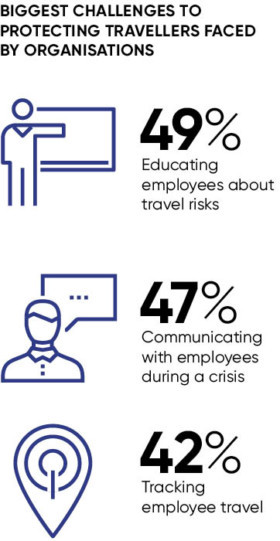 The need to prepare, protect and assist employees whenever and wherever needed has never been more evident. Not only is it a duty of care for any organisation, and increasingly has potential legal implications if employees are not appropriately protected, it is also high on the agenda to help business continuity planning and strengthen business resilience through a protected workforce.
The need to prepare, protect and assist employees whenever and wherever needed has never been more evident. Not only is it a duty of care for any organisation, and increasingly has potential legal implications if employees are not appropriately protected, it is also high on the agenda to help business continuity planning and strengthen business resilience through a protected workforce.
Rob Walker, security expert at International SOS, says: “Security events have resulted in a sense of increasing challenges, even in travel to places once thought secure. While risks are changing, organisations must ensure their actions to mitigate those changes are proportionate, and based on reality and not perception.
“With many organisations increasing their business travel activity,[1] it is essential for decision-makers to be able to communicate that objective advice to their people, including in an actual crisis. Keeping informed and taking into account all risk factors will enable business travel to proceed successfully, resulting in a protected workforce and business continuity.”
Travel risk professionals have told us the biggest challenges that organisations face in protecting their mobile workforce are education about travel risks, communication during a crisis and tracking travellers.[2] These are vital elements to keeping your workforce safe and an indication of what is preoccupying managers.
They also indicate something else as managers are in danger of being drawn into details that could be addressed more efficiently; time spent tracking people down and trying to communicate could be reduced to make additional time for addressing the bigger picture.
We know travel risk professionals are often multi-tasking across a number of business objectives and that risk responsibilities are shared across an organisation, so co-ordination and identifying responsibilities is essential, whether that is managing additional staff for a business objective or ensuring corporate data is protected. The impact of this is, of course, amplified during a major crisis, such as an extreme weather event or a terrorist attack which could affect a number of personnel rather than an individual.
So how do you save the time you’re losing? It all comes down to something that may be commonly known, but is often not prioritised, putting in place an optimum business continuity plan for business resilience in a crisis.
Business continuity planning can be complex, so the effort of building and maintaining it can be daunting, but is essential, looking after your people, managing client relationships and not just protecting your reputation, but enhancing it by embodying good practice. There are some simple steps that any organisation can take.
TOP TIPS TO IMPROVE RESILIENCE
01 Think ahead: how will you respond?
Think through likely scenarios and review appropriate sources such as a risk map (www.travelriskmap.com). You probably have previous experience you can draw on too. What was best practice? What are the likely pitfalls? What happens if you or your immediate team are unavailable?
Educate your managers on what they need to do. Remind people of the role they need to play. Protecting your workforce is everyone’s responsibility, but you cannot assume people will take this on intuitively. Spend time creating awareness and support so your managers feel a sense of ownership. This gives you more help to draw on and, if your people have a duty of loyalty, they will help you too.
02 During an incident: track, communicate, assist
Set up a system that will alert your people. Make sure you have a traveller tracking tool in place that will do the bulk of the work for you. You should also think about how and when you will get a message out to your whole organisation.
Work out how you will check your people are OK. It is essential to have this linked to your traveller tracking tool, to ease the overall management of what’s happening. Ideally you will get the message out through two-way communication to improve the response rate.
Have a back-up plan in case you can’t manage the crisis alone. Even the best organisations may be out of their depth if the worst happens. You will need a solution that can emulate your role if you are not in the office. One option is to nominate alternatives; another is to outsource the checking process completely.
03 The wash up: template your management reports
This is simple but very important if you want to show you are in control of the situation. Setting up a report template will help you communicate to your leadership and give you all piece of mind. Once again, hooking this into your traveller tracking tool will mean you can report and communicate in a matter of minutes.
Flexible response templates are key, enabling fast modification in a crisis, from cyber security incidents to national political upheaval.
Be prepared to support and protect your workforce with unparalleled advice and assistance. Travel risk management tools and services are key in helping organisations protect their mobile workforce in the most efficient way and mitigate risks to strengthen business resilience.
For more information please visit www.internationalsos.com
[1] Talent Mobility 2020 and Beyond, PwC
[2] International Travel: Risks and Reality: The New Normal for Business is an Ipsos MORI research study conducted among 1,119 business decision-makers across 75 countries. Research was conducted online using representative panels, October 6–26, 2016

